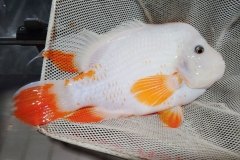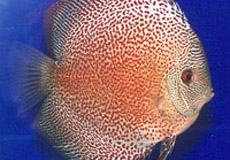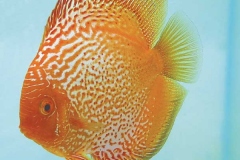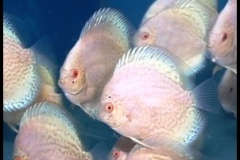In the last article we went over how to get your Angelfish to spawn. In this article we will go over the actual spawning process. The spawning process is everyone’s favorite part. This is what hooked me on Tropical Fish as a young boy and I still, 45 years after my first spawn, find it fascinating.. The first sign that your Angelfish are getting ready to spawn will be their obsession with cleaning the slate or breeding cone you provided. It will always be on a surface that is mostly vertical and if you do not provide a surface that meets that condition on which you want them to use for spawning, they will spawn on other surfaces that are much more difficult such as the side of the tank or filter tubing. Once you see both of them cleaning the spawning site, spawning will usually follow within a day or two. You will also see them start doing the mating dance. They will swim towards each other at a slightly upward angle. Once they get next to each other, they will shimmer and then swim away from each other at a slightly lowered angle. The mating dance is not always performed. I have found that Wild Caught Angelfish almost always do it, but later generations of tank raised strains often do not. The most spectacular aspect of the spawning will be the colors of your Angelfish. Whatever their color, it will become MUCH more intense and vibrant during spawning. This will be the prettiest you will ever see your Angelfish. They will also become aggressive toward other fish, including other Angelfish, at this time. They will aggressively defend the breeding site from all intruders, including you. If you put your hand in near the spawning site when they are preparing to spawn or have already spawned, they, usually the male, will bite your hand. While it really does not hurt much, they will do it very aggressively, it will startle you and it will be something you want to avoid. At some point after your Angelfish start doing all of the above, they will actually lay the eggs. It will start with the female rubbing her belly, and her breeding tube, against the surface that they have cleaned. She will always lay in an upwards motion. The total length of the spawning run will be between ½ and five inches. She will lay between 1 and 12 eggs per spawning run. They can lay over a thousand eggs at one spawning, but it it usually 3 to 5 hundred. The more mature the pair, the larger the spawn will be. The male Angelfish will usually then follow directly behind her in the same basic motion fertilizing the eggs. The entire process can take between one and five hours. The eggs will usually be beige This is when the fun is over and the frustration can start. The first two issues that you will be confronted with are eating of the eggs, especially by the male, and infertility. In the next article in this series, we will go over Angelfish eating the eggs.
Tag Archives: Eggs
Breeding Angelfish-Part 6- Eating of Eggs and Fry
We will now go over what to expect after the eggs have been laid. This is where the frustration starts. The first two issues that you will be confronted with are eating of the eggs and fry, especially by the male, and infertility. We will go over the eating of the eggs first. We will go over infertility in the next part of the series. One problem, and the one you must get past, with breeding Angelfish is the eating of the eggs, or fry once the eggs hatch out, by the parents. The good news is that only about 30% of the spawning Angelfish pairs will eat the eggs and another 20% will eat the fry as soon as they hatch out. This is a much lower percentage than with some other Cichlids such as Discus. While both parents will eat the eggs, the male does it more often. This is sometimes done as they spawn and there is very little you can do if this occurs while spawning. The female will make her egg-laying run and then the male, instead of following her with a fertilizing run, will follow her and eat the row of eggs. This behavior is most common in new pairs. Many new pairs will eat their eggs in the first couple of spawns and then eventually stop eating the eggs, so do not give up on them. If you get lucky and they do not eat their eggs when spawning, there is still a chance that they will eat them before they hatch. Fortunately, if you get this far, there is something you can do. You can, at this point, take the eggs out and artificially raise them or you can take a mesh screen (house soffit screen works very well) and fit it directly over the eggs. This will allow the Angelfish to still blow on the eggs and bond with them, but will keep them from eating the eggs. Obviously, you will need to have planned for the spawning and will need to have created the screen prior to the actual spawn. If the eggs do not get eaten and are fertile, they should hatch out in two days and become free swimming in about six days. In the next article, we will go over infertility.







